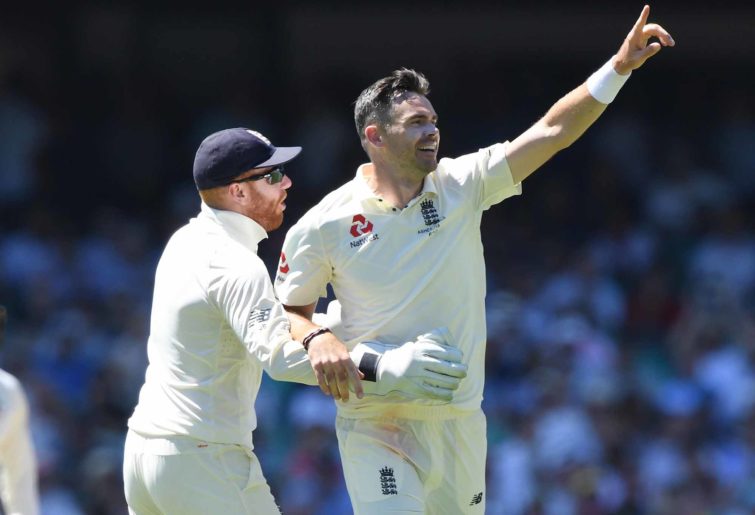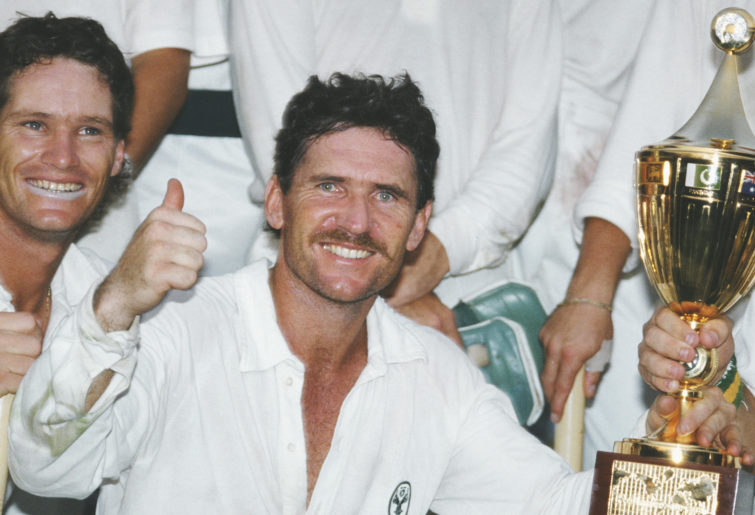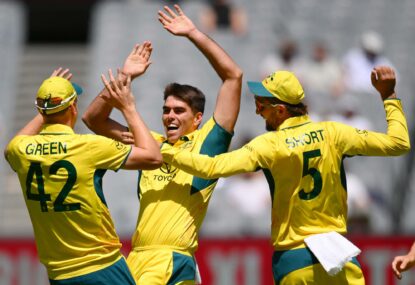The series’ fourth Test, between July-born English and Australian teams, will take place at Old Trafford.
England’s July-born team will be led by its most famous player, and contain a home-town hero who has taken more wickets than any of his countrymen. Its bowling quartet is extremely strong, and ideally suited for local conditions.
Australia’s July-born team will be captained by one of its toughest modern players, and include arguably its finest fast bowler of all time. Its wicketkeeper did not play a Test match, but has a fascinating background nevertheless.
Each team has a long tail, due to a lack of eligible all-rounders and wicketkeeper-batsmen.
Manchester’s ground has hosted 79 matches to date, including 30 for the Ashes. England has seven wins and Australia eight, and the remaining 15 have been drawn. Across those 30 matches England has a batting average advantage of 31.02 to 29.44, equivalent to a 31-run margin.
My tip for this match is that England will level the series at two wins apiece, thanks to home-ground advantage and a superior bowling attack, notwithstanding Australia’s more proven batting line-up.
England July-born
Peter Richardson
34 Tests, 1956-1963, 2061 runs at 37.47, five centuries
Richardson was a patient left-handed opening batsman. He used a short backlift, and deflected the ball well. Against Australia in his first series, he scored 81 and 73 on debut at Trent Bridge, and 104 at Old Trafford.
Charlie Barnett
20 Tests, 1933-1948, 1098 runs at 35.41, two centuries
Barnett was an aggressive opening batsman and reliable outfielder. His strongest strokes were the drive and cut. In Australia in 1936-37, he was England’s highest run-scorer with 395 runs at 43.88.
Against Australia at Trent Bridge in 1938, he reached his century from the first delivery after lunch on the match’s opening day. World War II, which commenced when he was aged 28, interrupted his career.
WG Grace (captain)
22 Tests, 1880-1899, 1098 runs at 32.29, two centuries, nine wickets at 26.22
Born 172 years ago, Dr William Gilbert Grace is arguably the most famous and influential cricketer of all time. He revolutionised the way the sport was played, and more than any other person made it popular.
In a first-class career lasting 44 years, he scored 54,211 runs at 39.45 and took 2809 wickets at 18.14, on generally poor pitches by modern standards.
He toured Australia before Test cricket commenced, but only once thereafter at the age of 43. His Test statistics do not do him justice, as he debuted aged 32 and played his last match aged 50. His two centuries were 152 at The Oval on debut, and 170 at the same ground in 1886.
He hit the ball hard off both front and back foot, enjoyed facing fast bowling, and bowled skilfully with a round-arm action. He was tall, and as a slim young man was a first-rate hurdler and runner. Despite his amateur status, he unashamedly earned far more from cricket than any professional player.
The deaths of both he and Victor Trumper in 1915 helped the Wisden Cricketers’ Almanack containing their obituaries to become the most valued of all editions.

You can’t spell grace without WG Grace (Public domain)
Graham Gooch
118 Tests, 1975-1995, 8900 runs at 42.58, 20 centuries
Gooch was a top-order batsman and occasional slow-medium bowler. On debut at Edgbaston in 1975, he scored a pair against Australia. In 42 matches against Australia he scored 2632 runs at 33.31, including four centuries.
However, in 26 matches against the West Indies he averaged 44.83, with five centuries. Against India at Lord’s in 1990, he scored 333 and 123. He scored more runs in first-class and List A cricket combined, than Sir Jack Hobbs did in first-class cricket.
His career was interrupted by a three-year ban for leading a rebel tour to South Africa.
Maurice Leyland
41 Tests, 1928-1938, 2764 runs at 46.06, nine centuries
Leyland was a left-handed middle-order batsman with an exceptional Ashes record of 1,705 runs at 56.83, including 768 runs at 64.00 with four centuries in nine home matches.
His Ashes highlights were 137 and 53 not out on debut at the MCG in 1928-29, centuries at Lord’s and Old Trafford in 1934, and 187 at The Oval in 1938 in his final Test. He also bowled left-arm wrist-spinners well enough to take 466 first-class wickets.
Joe Hardstaff Jr
23 Tests, 1935-1948, 1636 runs at 46.74, four centuries
Hardstaff was an elegant batsman who both attacked and defended well, and a fine outfielder. His Ashes highlight was 169 not out in a total of 7(dec) 903 at The Oval in 1938.
World War II, which commenced when he was aged 27 and during which he served in Burma, interrupted his career. His father Joe Sr played five Test matches and also umpired at Test level.
Bob ‘Chat’ Taylor (wicketkeeper)
57 Tests, 1971-1984, 167 catches, seven stumpings
Taylor was an outstanding wicketkeeper and Alan Knott’s understudy for a decade. Until Knott signed with World Series Cricket in 1977, Taylor had played only one match. He was also a dogged tail-end batsman, averaging 16.28 and scoring three half-centuries.
Tony Lock
49 Tests, 1952-1968, 174 wickets at 25.58
Lock was a left-arm finger-spinner with a fast bowler’s aggressive attitude, and an outstanding short-leg fieldsman. He and Jim Laker formed a lethal combination at both County and Test level. In nine Ashes matches in England, he took 26 wickets at 28.92.
He took 5-28 and 6-20 against the West Indies at The Oval in 1957, and 34 wickets at 7.47 against New Zealand in 1958. He later captained Western Australia to the Sheffield Shield in 1967-68, after taking 50 wickets the previous season. In the ICC’s all-time bowler standings, he is ranked ninth.
Sir Alec Bedser
51 Tests, 1946-1955, 236 wickets at 24.89
Bedser was a medium-fast bowler whose strengths were his inswinger and leg-cutter, and accuracy. He spearheaded the regaining of the Ashes in 1953 by taking 39 wickets at 17.48 when aged 35, including 7-55 and 7-44 at Trent Bridge.
At the MCG in 1950-51, he took 5-46 and 5-59. He played against Australia 21 times, taking 104 wickets at 27.49. In the ICC’s all-time bowler standings, he is ranked twentieth. World War II delayed his Test career, ending only when he was aged 27. His identical twin Eric was a long-serving first-class cricketer.
James Anderson
151 Tests, 2003-present, 584 wickets at 26.83
Anderson is a fast-medium swing bowler and modest left-handed batsman, and England’s highest wicket-taker. To date he has taken 368 wickets at 23.76 in 90 matches at home, including 44 wickets at 33.38 in 14 Ashes matches.
Against Australia at home, his best match figures are 5-85 and 5-73 at Trent Bridge in 2013. At Old Trafford he has played seven matches and taken 28 wickets at 21.78, including 0-116 and 2-37 in his only match against Australia.

England’s James Anderson (AAP Image/David Moir)
Ken Farnes
15 Tests, 1934-1939, 60 wickets at 28.65
Farnes was a tall fast bowler who sadly lost his life aged 30 during World War II, when the aircraft that he was piloting crashed. On his debut, he took 5-102 and 5-77 against Australia at Trent Bridge. When Australia scored 604 at the MCG in 1936-37 on a perfect pitch, he took 6-96. In eight Ashes matches, he took 38 wickets at 28.02.
Honourable mentions
Andrew Sandham, Lucky Denton, Tony Lewis, Paul Gibb, Sir Gubby Allen, Bill Bowes, George Geary.
Australia July-born
Charles Bannerman
Three Tests, 1877-1879, 239 runs at 59.75, one century
Bannerman was a polished top-order batsman with a wide range of strokes who faced Test cricket’s first delivery and scored its first century.
His chanceless 165 retired hurt represented 67.3per cent of Australia’s total score of 245, a record that is still standing 143 years later. At stumps on the first day of the match, his score was 126 not out in a total of 6-166. He toured England, New Zealand and Canada in 1878, scoring a century in each country, but the tour did not include any Test matches.
Illness cut short his career, and he later umpired in 12 Test matches between 1887 and 1902.
Bill Brown
22 Tests, 1934-1948, 1592 runs at 46.82, four centuries
Brown was an outstanding if unspectacular opening batsman, and excellent fieldsman. He played 11 of his matches in England, scoring 885 runs at 46.57 with three centuries including 206 not out at Lord’s in 1938. His career was interrupted at the age of 27 by the commencement of World War II, in which he served and reached the rank of Flight Lieutenant.
On his first-class debut, he was run out without facing a ball. During India’s tour to Australia in 1947-48, Vinoo Mankad twice ran him out for backing up too far, thereby creating the modern nickname for that mode of dismissal.
Keith Stackpole
43 Tests, 1966-1974, 2807 runs at 37.42, seven centuries
Stackpole was an attacking batsman who particularly enjoyed playing hook and cut shots. Against England in 1970-71, he topped Australia’s averages with 627 runs at 52.25 including a double-century and century.
In 1972 in his only series in England, he was the highest scorer for either side with 485 runs at 53.88. Against New Zealand in his final match, he scored a pair. His father played 20 matches for Victoria.
Allan Border (captain)
156 Tests, 1979-1994, 11,174 runs at 50.56, 27 centuries, 39 wickets at 39.10
Border was a gritty left-handed batsman, useful left-arm orthodox spin bowler, and outstanding fieldsman. He led Australia to a World Cup victory and three Ashes series wins, as well as Queensland to its first Sheffield Shield title.
In 25 matches in England, he scored 2082 runs at 65.06 including five centuries and a highest score of 200 not out. He averaged 56.57 away overall, and more than 50.00 in England, India, New Zealand, Pakistan and the West Indies.
Arguably his finest batting performance was 98 and 100, both undefeated, in Port-of-Spain in 1983-84. With the ball, his highlight was a match-winning 7-46 and 4-50 against the West Indies at the SCG in 1988-89.
He was named in Cricinfo’s all-time Australian team, and Australia’s annual Player of the Year Award is named in his honour.

Australia celebrate winning the 1987 Cricket World Cup. (Photo by Allsport/Getty Images)
Stan McCabe
39 Tests, 1930-1938, 2748 runs at 48.21, six centuries, 36 wickets at 42.86
McCabe was a cavalier middle-order batsman at his best against pace bowling, and useful medium-paced bowler. He played some of the most famous innings in Australian cricket history.
At the SCG in 1932-33 he overcame England’s Bodyline tactics by counter-attacking to score 187 not out. In Johannesburg in 1935-36 he scored 189 not out, reportedly prompting South Africa’s captain to appeal against the light out of fear of injury to fieldsmen. At Trent Bridge in 1938 he scored a run-a-minute undefeated 232.
Marcus North
21 Tests, 2009-2010, 1171 runs at 35.48, five centuries, 14 wickets at 42.21
North was a left-handed batsman and useful off-spin bowler. He commenced a brief career with 117 on debut at the Wanderers. In England in 2009 he scored 125 not out in Cardiff, 96 at Edgbaston and 110 at Headingley. In New Zealand in 2009-10 he scored 112 not out and 90 in Wellington and Hamilton respectively.
At neutral venue Lord’s in 2010, he took 6-55 against Pakistan. He also played for five different English counties. His inconsistency with the bat ultimately counted against him.
Dennis Lillee
70 Tests, 1971-1984, 355 wickets at 23.92
Lillee was one of Australia’s greatest and most intimidating bowlers, both technically-skilled and genuinely fast. He formed outstanding partnerships with wicketkeeper Rod Marsh and paceman Jeff Thomson, averaged more than five wickets per match, and took ten wickets in a match seven times.

Dennis Lillee, left, and Jeff Thomson, (PA Images via Getty Images)
In Ashes matches he took 167 wickets at 21.00, including 96 at 20.56 in 16 matches in England. His match-winning performances included 8-29 and 4-63 against the World XI at the WACA in 1971-72, 5-58 and 5-123 at The Oval in 1972, 6-26 and 5-139 in the Centenary Test at the MCG in 1976-77, and 7-83 and 3-44 against the West Indies at the MCG in 1981-82.
His Test career was interrupted by a serious back injury at a young age, and later by World Series Cricket. He was named in both Cricket Australia’s Test Team of the Century, and Cricinfo’s all-time Australian team.
Stan Sismey (wicketkeeper)
35 first-class matches, 1938-1952, 88 catches, 18 stumpings
No wicketkeeper born in July has represented Australia. Therefore I was delighted to discover that Stan Sismey was born on 15 July. He played eight times for New South Wales before WWII, which commenced when he was aged 23.
In 1942 the Catalina flying boat that he was co-piloting was shot down over the Mediterranean, and after floating for eight hours he was rescued unconscious and injured.
During WWII’s final years he served as a Test pilot in Scotland, where he met his wife Elma. Post-war, as a Squadron Leader he was commanding officer of the famous Australian Services XI that included Lindsay Hassett and Keith Miller.
It played five Victory Tests against England in 1945, and subsequently also in India, Ceylon and Australia. He continued to play for NSW until 1952, and subsequently once also for Scotland.
He served as a NSW selector for 20 years, and a Vice-President of the NSW Cricket Association.
Ashley ‘Rowdy’ Mallett
38 Tests, 1968-1980, 132 wickets at 29.84
Mallett was a fine off-spin bowler and outstanding gully fieldsman.
His best Test figures were 1-52 and 8-59 against Pakistan at Adelaide Oval in 1972-73, and 5-91 and 5-53 against India in Madras in 1969-70. In Ashes series he took 50 wickets at 31.62, including 26 at 34.80 in eight matches in England. He was born in Sydney, grew up in Perth, and moved to Adelaide to be coached by Clarrie Grimmett.
His career was interrupted by two seasons of World Series Cricket. He later wrote and published a number of biographies of famous cricketers including Victor Trumper and Grimmett.
Doug ‘The Rug’ Bollinger
12 Tests, 2009-2010, 50 wickets at 25.92
Bollinger was a left-armed fast bowler who used angle and swing effectively during a brief Test career. In 2010, the ICC named him in both its Test and One-Day International Teams of the Year. His Test highlights included 5-70 and 3-71 against the West Indies at the WACA, and 5-28 and 2-80 in Wellington.
He returned to international cricket four years later, to play seven T20 matches and participate in the T20 World Cup.
Alan Hurst
12 Tests, 1974-1979, 43 wickets at 27.90
Hurst was a genuinely fast swing bowler who partnered Rodney Hogg with the new ball in 1978-79. In six matches against England he took 25 wickets at 23.08, then in two matches against Pakistan he took 15 wickets at 21.66 including 4-61 and 5-94 at the WACA.
He had toured England in 1975 without playing a Test match. He was a poor batsman who scored ten ducks and three pairs in 20 innings. He later served as an ICC match referee.
Possible tour party members
Shaun Marsh, Jack Moroney, Geoff Dymock, Jim Higgs, Ray Bright, Jack Iverson.








































































































